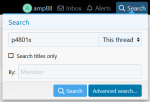Hey friends,
I am going to purchase a device for SLOG use and I am considering the following 2 options:
SSDPED1K375GA01 INTEL Optane SSD DC P4800X 375GB 1/2 Height PCIe x4 3D XPoint Single Pack
OR
SSDPEL1K200GA01 INTEL Optane SSD DC P4801X 200GB M.2 110MM PCIe x4 3D Xpoint Single Pack
If I buy the M.2 version I will also need to purchase the following adapter - Supermicro AOC-SLG3-2M2-O
For latency and write IOPS the best is INTEL Optane SSD DC P4800X 375GB. But with the second option (M.2) I can expand in the future and use another M.2, what would you do? Are the differences critical to SLOG and will affect performance if I choose an adapter with M.2?
I am going to purchase a device for SLOG use and I am considering the following 2 options:
SSDPED1K375GA01 INTEL Optane SSD DC P4800X 375GB 1/2 Height PCIe x4 3D XPoint Single Pack
OR
SSDPEL1K200GA01 INTEL Optane SSD DC P4801X 200GB M.2 110MM PCIe x4 3D Xpoint Single Pack
If I buy the M.2 version I will also need to purchase the following adapter - Supermicro AOC-SLG3-2M2-O
For latency and write IOPS the best is INTEL Optane SSD DC P4800X 375GB. But with the second option (M.2) I can expand in the future and use another M.2, what would you do? Are the differences critical to SLOG and will affect performance if I choose an adapter with M.2?

